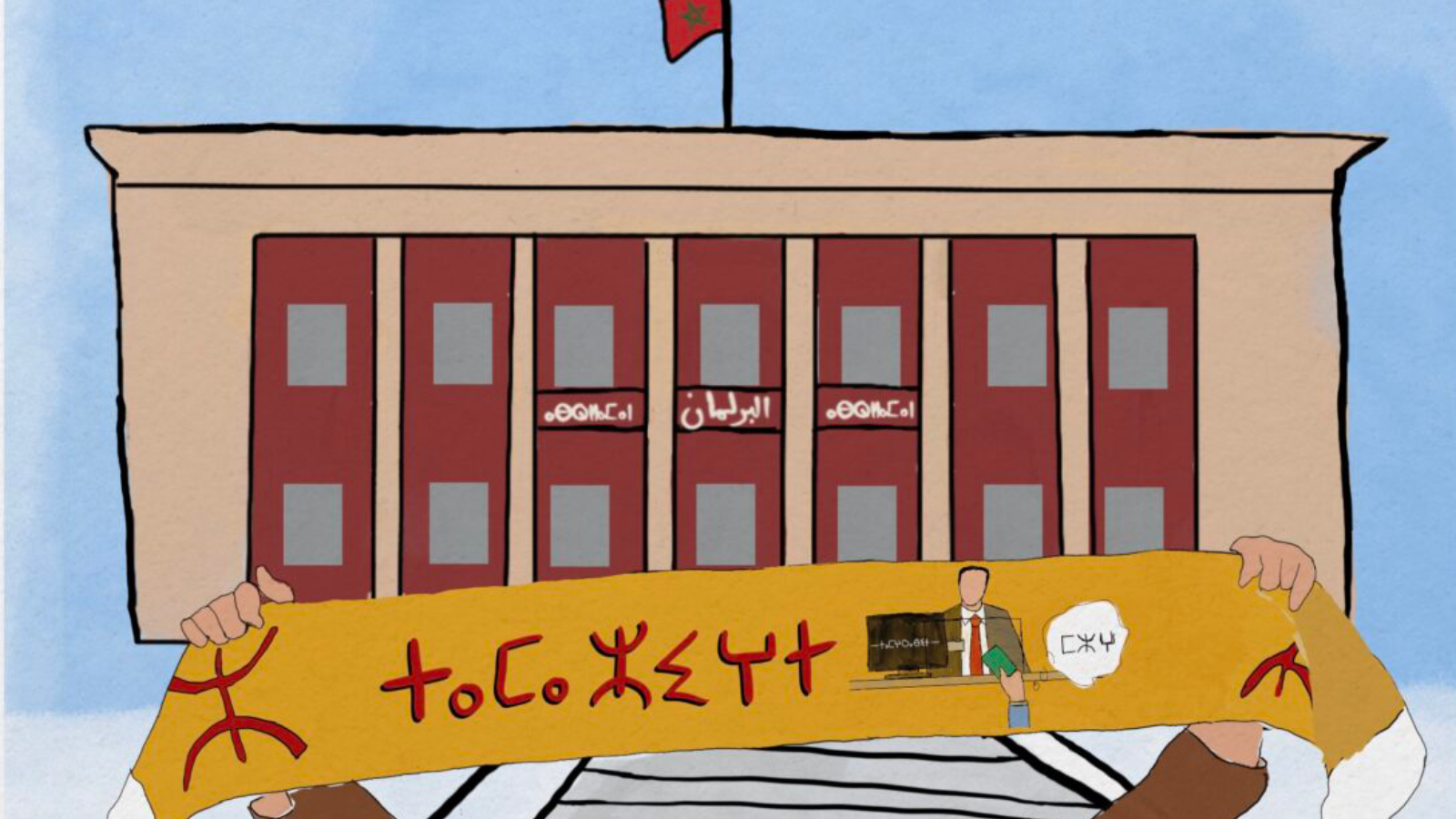
This article is written by Mohammed Udern
As a child, Mohammed Ait Amghar, a shopkeeper from the Azilal region in Morocco, could only speak his native language, Tamazight. In 1982, when he was 8 years old, he felt unwell in class, his teacher sarcastically asked him in colloquial Moroccan Arabic (Darjah), “Have you eaten bran?” referring to livestock feed. Mohammed, who had limited Arabic skills, misunderstood the question and the sarcasm in it, innocently replied “Yes.” This incident led to bullying from his classmates at school and had a profound impact on his life, as he shared with Global Voices:
“ⴰⵔ ⴱⴰⵀⵔⴰ ⵜⵜⵎⵏⴰⵍⴰⵏ ⵉⵎⵙⵍⵎⴰⵣⵉⵖⵏ ⴽⵔⴰ ⵏ ⵡⴰⴷⴷⴰⴷ ⴳ ⵉⴳⴳⵓⵜ ⵓⵣⵓⵅⵓ, ⵙ ⵍⴰⵡⴰⵏⵏ ⴰⴽⴽⵯ ⴰⴷⴷⴰⵢ ⵜⵜⵎⵉⵇⵇⵉⵔⵏ ⴰⴽⴷ ⵉⴳⴷⵓⴷⵏ ⵙⴰⵡⴰⵍⵏⵉⵏ ⵙ ⵜⵓⵜⵍⴰⵢⵜ ⵜⴰⵄⵕⴰⴱⵜ, ⴰⵢⵏⵏⴰ ⴰⵙⵏ ⵉⵜⵜⵙⵔⴰⴳⵏ ⴳ ⵓⵖⵓⵏⴼⵓ ⵙⴳ ⵜⵓⵜⵍⴰⵢⵜ ⵜⴰⵢⵎⵎⴰⵜ ⵏⵏⵙⵏ ⴷ ⵜⵔⵡⵍⴰ ⵙⴳ ⵓⵙⵙⵎⵔⵙ ⵏⵏⵙ.”
Tamazight speakers often face difficult situations, especially when interacting with Arabic-speaking communities. This can lead to them feeling bullied and discouraged from using their native language. As a result, they may develop an aversion to speaking it openly.
Over time, many native Amazigh in North Africa have lost their proficiency in the Tamazight language as a result of historical and sociocultural factors like Phoenician dominance, Roman occupation, Islamic conquest, and, later, French colonization.
The declaration of incoming languages like French and Arabic as official languages in addition to modern social and economic factors further led to the marginalization of Amazigh culture and language, restricting its presence in public life, and limiting access to information and services. As a consequence, Amazigh has transformed from a practical communication tool into a symbol of identity for the Amazigh people.
Tamazight at a glance
- Number of Tamazight variations: 40
- Number of dialects: 5
- Dialects include: Eastern (Ghadames-Nafusi), Northern (Kabyle-Rif-Tashlhhiyt), Western (Azennag and Tetserret), Tuareg (Tamahaq-Tamajeq-Tawellemet), and Guanches.
- Number of countries where Tamazight is spoken: 13
- Countries include: Morocco, Algeria, Libya, Mali, Niger, and others. It is also present in diaspora countries, such as France, Canada, and others.
Tamazight boasts a diverse history spanning thousands of years with numerous dialects.
Due to political sensitivity, there are no precise studies on the exact number of Tamazight speakers. However, the journal Ethnologue estimates that Morocco has the largest group of Tamazight speakers, with approximately 13.8 million (in 2017), followed by 8.8 million in Algeria (2020), and then France with around 11.5 million speakers (2022). Amazigh was officially recognized in Algeria in 2016 and in Morocco in 2011, signifying crucial milestones in preserving its language and cultural heritage.
The impact of Tamazight language insecurity on civic participation in Morocco
Language is a powerful tool reflecting cultural identity and social belonging. It plays a crucial role in accessing and exchanging information, shaping knowledge sharing. In an interview with Global Voices, Dr. Abdullah Bouzndag, an expert in sociolinguistics and didactic teaching of Amazigh at the Royal Institute of Amazigh Culture, highlighted Tamazight’s inadequate integration in society in Morocco:
Access to information is a fundamental right for Tamazight speakers nationwide, acknowledged by all international human rights conventions. Unfortunately, it is often inadequately provided in government and public services, even though its inclusion does not require significant financial resources.
Monolingual Tamazight speakers face challenges when trying to integrate into society and participate in civic activities. These difficulties stem from their limited access to knowledge and public services resulting from their native language's absence from public life. As per Dr. Bouzndag's perspective:
It is natural that the deprivation of any human group of its cultural rights would have a negative impact on the behavior of its members. Linguistic insecurity can directly lead to institutions being boycotted, as evidenced by the Amazigh movement’s boycott of elections prior to 2011. Additionally, it may cause a general reluctance to participate in politics, serving as an expression of dissatisfaction.
A large number of Amazigh associations, the Amazigh Citizenship Network, and the Moroccan Amazigh Democrat Party boycotted the parliamentary elections in 2007 due to “the lack of recognition for Amazigh identity and the Tamazight language in the constitution, as well as the state's ongoing marginalization of Amazigh concerns.”
The Amazigh rights debate in Morocco began in the 1960s through various associations. However, the official response from the state came in the 21st century, gaining momentum after King Mohammed VI's historic speech in Agadir on October 17, 2001. He emphasized that Tamazight belongs to all Moroccans and is a fundamental element of Moroccan culture. The official recognition of the Tamazight language came in July 2011, in the wake of the Arab Spring protests in Morocco, where people demanded democratic reforms.
Obstacles to accessing information and services
Morocco has made significant strides in recognizing and promoting the Tamazight language by establishing a legal framework to support its development. Yet, inconsistent government commitments hinder its growth. Consequently, Tamazight still faces obstacles, including limited official support and integration in key sectors like education, healthcare, judiciary, and public administrations.
At the individual level, Amazigh people face challenges communicating with government institutions due to the absence of information and services in Tamazight . This hampers their engagement in public affairs, as they struggle to understand laws and government procedures, leading to their marginalization and limited integration into urban communities. Overcoming these obstacles requires mastering Arabic or French.
Moreover, linguistic barriers significantly affect the job prospects of those who primarily speak Tamazight. French fluency requirements in both the public and private sector hinder formal employment opportunities, pushing many to informal and low-paying jobs like agriculture and construction. The absence of an official framework for services, information, and job opportunities exacerbates higher unemployment rates and economic hardship within the Amazigh community.
The fight for equal opportunities
Despite being introduced in primary education in 2003, the Tamazight language remains weak in 2023. Minister of National Education Said Amzazi’s statement reveals that less than 500,000 students benefit from Amazigh classes out of 7 million annually, with only 9,000 Tamazight language teachers since 2003. Tamazight has never been introduced in middle and high schools, and the allocated time for its teaching is limited to three hours weekly.
The Ministry of National Education aims to enhance Tamazight in education by 2030. However, the Amazigh movement sees this initiative as lacking a clear roadmap for effective language teaching promotion.
The judicial branch isn’t doing much better; litigants must learn colloquial Arabic to handle their cases in Moroccan courts. Amazigh families share stories about their experiences in court, particularly among the elderly who solely speak Tamazight.
One such story was shared with Global Voices. Othman's grandfather, Si Hassayen from Azilal, received an absentia sentence in the late 1990s in a land dispute case despite being present in the courtroom. His inability to understand colloquial Moroccan used during the proceedings led to this unfortunate outcome. He said:
“ⵎⵇⵇⴰⵕ ⵜⴰⴹⵚⴰ ⵏⵏⴰⵖ ⴼ ⵡⴰⴷⴷⴰⴷ ⴰⴷ ⴳ ⵜⴰⵡⵊⴰ, ⵎⴰⵛ ⴷⴰⵔ ⵊⴷⴷⵉ ⵓⵔ ⵉⴳⵉ ⴰⵣⵔⴼⴰⵏ. ⵉⵣⵓⵅⵅⴰ ⵢⴰⵏ ⵙⴳ ⵉⵎⵙⵡⵡⵔⵉⵏ ⵏ ⵜⵙⵏⴱⴹⴰⵢⵜ ⵙ ⵢⴰⵏ ⵓⵙⵇⵇⵙⵉ ⵓⴹⵏⵉⵥ “ⵉⵙ ⴰⵛⵍⵃⵉ ⴰⴷ ⵜⴳⵉⵜ, ⵉⵙ ⵓⵔ ⵜⵙⵙⵉⵏⴷ ⵜⴰⵄⵕⴰⴱⵜ !”
Although we laughed about this incident within the family, it was truly unfair to my grandfather. He was bullied by one of the court employees who asked mockingly, “Are you illiterate? Don't you know Arabic!”
United Nations’ reports highlight a significant decline in the number of Tamazight speakers in Morocco. Some dialects have already gone extinct in recent years, like the Tamazight language of Ait Rowadi in the Azilal region. Other dialects, such as the language of the Oases in the eastern region, are also on the brink of extinction, with only a few thousand speakers remaining.
A positive shift in Amazigh status
Web 2.0 has sparked a revolution in making information available in the Tamazight language, particularly among the youth. They can now easily communicate in their native tongue through social media platforms and digital channels like YouTube. As a result, there has been a notable increase in awareness of the Amazigh identity across all levels in Morocco, including within official institutions and Amazigh political movements, leading to significant progress and achievements.
Nonetheless, there is a noticeable disparity between Amazigh civil society and the official sector online. The representation of the Tamazight language on public sector websites mirrors this reality. Official Amazigh websites have limited content, poor quality, and many spelling errors, making them unpopular in the Amazigh community. For instance, although the official website of the prime minister is available in Arabic, French, and Tamazight, the Amazigh content has not been updated for years, despite the importance of engaging with citizens.
The Royal Institute of Amazigh Culture remains the only official website with quality resources.
Numerous initiatives, both individual and collective, are boosting the presence of the Tamazight language and culture online. Many of them offer high-quality resources and enjoy substantial popularity. Examples include the 2021 launch of the Tamazight Wikipedia, driven by the efforts of up to 800 volunteers, regional-based dictionary websites, private news portals, digital libraries, and entertainment platforms, all with thousands of followers.
Morocco has made progress in internal reconciliation by amending laws to address the demands of Tamazight speakers. However, the challenge remains in effective implementation. Respecting Tamazight language rights and promoting linguistic equality will foster social integration and provide Tamazight speakers with the freedom to express their culture and identity openly, and enable them to participate more actively in civic life.
Ait Amghar feels that the progress in Amazigh rights in Morocco has improved a lot since the incident when he was eight years old:
ⴰⴷⴷⴰⴷ ⵏ ⵜⵎⴰⵣⵉⵖⵜ ⴳ ⵍⵎⵖⵔⵉⴱ ⵉⵏⵏⴼⵍ ⵙ ⴽⵉⴳⴰⵏ. ⵜⴰⵖⵓⵍ ⵜⵎⴰⵣⵉⵖⵜ ⵜⴳⴰ ⵜⵓⵜⵍⴰⵢⵜ ⵜⴰⵎⴰⴷⴷⵓⴷⵜ ⴳ ⵍⵎⵖⵔⵉⴱ, ⴰⵔ ⵜⴻⵜⵜⵓⵖⵔⴰ ⴳ ⵜⵉⵏⵎⵍ ⴷ ⴰⵔ ⵜⴻⵜⵜⵉⴳⵓⵜ ⵜⵉⵍⵉⵜ ⵏⵏⵙ ⴳ ⵜⵓⴷⵔⵜ ⵜⴰⴽⵓⵢⴰⵙⵜ ⵉⵎⵉⴽⴽ ⵙ ⵉⵎⵉⴽⴽ ⵎⵇⵇⴰⵔ ⵍⵍⴰⵏⵜ ⵜⵏⵎⴰⵔⵉⵏ ⴳ ⵓⵎⵏⵉⴷ ⵏ ⵓⵣⵣⵓⴳⵣ ⵏⵏⵙ ⴳ ⵜⵉⵍⴰⵡⵜ.
There have been big changes in the status of the Tamazight language in Morocco. Things have really improved since then! Now, it's officially recognized and taught in schools. Even though there are still challenges in terms of implementation.


